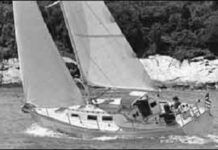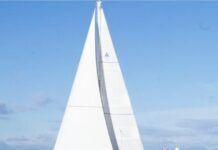Morgan 34
By today's standards, the Morgan 34 is a small boat, comparable in accommodations to a lot of 30-footers. When the boat was designed, she was as big as most other boats of her overall length. In profile, the boat has a sweeping, moderately concave sheer. The ends of the boat are beautifully balanced: the bow profile is a slight convex curve, the overhanging counter aft is slightly concave. Esthetically, hull shapes of this period from the best designers are still hard to beat.
Cal 34
Bill Lapworth didn't invent light-displacement cruiser-racers, but his name is indelibly linked with the type. At 15,000 pounds of displacement on a 30' waterline, the Cal 40 is still a fairly light boat, especially considering the low-tech materials and techniques available when she was introduced. Lapworth designed a number of smaller sisters to the Cal 40 in the late 1960's, all looking as alike as peas in a pod.
Luders 33
The Luders 33 was designed by Bill Luders and built by Allied Yachts of Catskill, NY, from 1966 to 1974. The builder of the Luders 33, Allied Yachts, had a troubled existence, struggling for survival from the early 1970s until the firm finally succumbed for good in 1981. Throughout its nine year production run, a bit more than 100 Luders 33s were built. Still, like such similar boats as the Alberg 30, the relative scarcity and traditional styling have made it a bit of a cult object.
Contest 35S
Conyplex, builder of the Contest 35S, is an established company that was a pioneer in fiberglass boat construction. In 1958, it began work on fiberglass Flying Dutchmans, and two years later introduced the Contest 25, its first cruiser. More than 5,000 boats have been built since, with about 600 of these being exported to the U.S. through Van Breems Holland Yachts of Westport, Connecticut.
J/34c
In appearance, the J/34c looks much like her sister J/cruisers. She has a fixed shoal draft keel, a straight sheer, and a slotted Goiot aluminum toerail. Her waterline, at 30', is long. It leaves her little overhang for appearance.
Catalina 34
It doesn't take a lot of brains to see that Catalina is doing something right that a lot of other sailboat makers aren't. They're the largest sailboat builder in the country, and a terrible year for them would be Valhalla for almost every other manufacturer. With more than 1,000 built in seven years, the Catalina 34 has to be in the running as the most successful production boat of the 1980s.
UWB 333
The arithmetic of weights and displacements prevents us from ever realizing a trailerable boat that will sail at the preferred half-submerged condition of our hypothetical craft. But you can get a trailerable hull by this scheme that will sail about one-third submerged, which probably is close enough, and that boat will have more than enough righting moment for reasonable sail-carrying. You also can get a boat that weighs relatively little out of the water compared to its displacement in the water--exactly the characteristic you want in a blue-water trailer sailer. I describe this design as "Ultra Water Ballasted."
Freedom 33
In 1972 Garry Hoyt set about developing the original Freedom 40. Discarding conventions one by one, he came up with a long-waterline, quasi-traditional hull form and a wishbone cat-ketch rig. In the intervening years Hoyt refined his rig and developed a whole line of boats: a 21, 25, 28, 39 (express and pilothouse models), and the 44. The Freedom 33 is no longer in production, having been replaced in the line by the 32, which is a single masted "cat sloop" with a self tacking jib and gun mount spinnaker. More rig innovation.
Ericson 35
Ericson Yachts has gotten a lot of mileage out of 35-footers over the years. In 1965, the first Ericson 35 was a typical CCA cruising boat; in 1969, the Ericson 35-2 was introduced--an up-to-date racer/cruiser, with swept-back moderate fin keel, pronounced bustle, and semi-balanced shallow spade rudder. In 1982 it was replaced by the 35-3, a larger, more modern boat.
Corsair F-31
The F-31 presents an aesthetically pleasing design with its fine entry; low, 27-inch freeboard; and fine lines. A flat aft section prevents the stern from burying when the bow rises in heavier breezes. Even when sailed on a broad reach with the windward ama out of the water, Farrier believes that his multis are more comfortable than a monohull sailed at a comparable angle of heel. Owners agree that being able to launch from a beach, or sail into a shallow anchorage, adds to the boat's overall utility and their enjoyment of the sport.












































